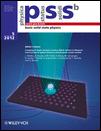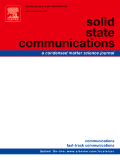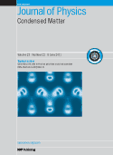
PHYSICA STATUS SOLIDI B-BASIC SOLID STATE PHYSICS
Scope & Guideline
Connecting Researchers Through Groundbreaking Physics Insights
Introduction
Aims and Scopes
- Solid-State Physics:
The core focus of the journal is solid-state physics, including the study of crystalline and amorphous materials and their properties. - Materials Characterization:
Papers often emphasize advanced characterization techniques such as spectroscopy, microscopy, and diffraction methods to investigate material properties at the atomic and molecular levels. - Computational Modelling:
The journal includes numerous studies that utilize computational methods, including first-principles calculations, density functional theory (DFT), and Monte Carlo simulations to predict and analyze material behavior. - Nanostructures and Low-Dimensional Materials:
There is a significant emphasis on research involving nanostructured materials, including quantum dots, nanowires, and layered materials, exploring their unique properties and potential applications. - Thermoelectric and Magnetoelectric Materials:
Research on materials with thermoelectric and magnetoelectric properties is a prominent theme, focusing on their applications in energy conversion and storage. - Optoelectronic Devices:
The journal publishes studies related to the design, fabrication, and characterization of optoelectronic devices, such as LEDs, solar cells, and sensors.
Trending and Emerging
- Emerging Two-Dimensional Materials:
There is a significant increase in research focused on two-dimensional materials such as graphene, transition metal dichalcogenides, and other layered materials, emphasizing their unique properties and applications in electronics and photonics. - Advanced Characterization Techniques:
The use of advanced characterization techniques, such as scanning tunneling microscopy (STM) and atomic force microscopy (AFM), is on the rise, allowing for more detailed investigations of material properties at the nanoscale. - Machine Learning in Materials Science:
The integration of machine learning and artificial intelligence in materials science is a rapidly growing trend, facilitating the discovery and optimization of new materials and predicting their properties. - Hybrid and Composite Materials:
Research on hybrid and composite materials that combine different types of materials to achieve superior properties is becoming increasingly popular, particularly in the context of energy applications. - Quantum and Topological Materials:
Emerging studies on quantum materials and topological insulators are gaining prominence, reflecting interest in their unique electronic properties and potential for next-generation technologies.
Declining or Waning
- Classical Semiconductor Theory:
Papers strictly adhering to classical semiconductor theory are becoming less frequent, as researchers increasingly explore advanced materials and novel phenomena that extend beyond traditional semiconductor physics. - Bulk Material Studies:
There is a noticeable decline in studies focusing solely on bulk materials without considering nanostructuring or heterostructuring, as the field shifts towards investigating the properties of materials at the nanoscale. - Low-Dimensional Systems in Isolation:
Research on low-dimensional systems (e.g., 2D materials) in isolation is less common, with a growing trend towards exploring their interactions and heterostructures with other materials instead.
Similar Journals

Physics and Chemistry of Solid State
Pioneering Discoveries in Physics and Chemistry of Solid-StatePhysics and Chemistry of Solid State is a distinguished open access journal published by Vasyl Stefanyk Precarpathian National University in Ukraine, dedicated to advancing research in the fields of condensed matter physics, materials science, and physical and theoretical chemistry. Since its inception in 2000, the journal has provided a platform for the dissemination of innovative ideas and original research findings, contributing significantly to the global scientific community. With a variety of access options, it facilitates the sharing of knowledge and collaboration among researchers worldwide. The journal has garnered recognition with respectable rankings in Scopus, positioning itself among the significant publications in its domain, particularly noted for its contributions to materials science and condensed matter physics. As it moves through its converged years from 2018 to 2024, Physics and Chemistry of Solid State aims to foster interdisciplinary dialogue and prepare the next generation of scientists to tackle complex challenges in solid-state research.

SOLID STATE COMMUNICATIONS
Connecting Researchers with Cutting-Edge DiscoveriesSOLID STATE COMMUNICATIONS is a prestigious journal published by Pergamon-Elsevier Science Ltd, dedicated to disseminating cutting-edge research in the fields of Chemistry, Condensed Matter Physics, and Materials Chemistry. With an ISSN of 0038-1098 and an E-ISSN of 1879-2766, the journal has established itself as a vital resource for researchers and professionals seeking to explore the fundamental properties and innovative applications of solid-state materials. As of 2023, it boasts a commendable standing, ranking in the Q2 quartile across its various categories, reflecting its impactful contributions to the scientific community. The journal is indexed in Scopus, further validating its relevance and quality, with notable ranks close to the median percentile in key areas. While SOLID STATE COMMUNICATIONS does not currently offer Open Access options, it remains a highly regarded source for rigorous scientific inquiry and open discussions, with a publication history dating back to 1963 and continuing to 2024. The journal serves as an essential platform for disseminating groundbreaking findings and fostering collaboration within the vibrant fields of solid state science.

JOURNAL OF PHYSICS-CONDENSED MATTER
Innovating Research for a Solid-State Future.JOURNAL OF PHYSICS-CONDENSED MATTER, published by IOP Publishing Ltd, stands as a premier platform for the dissemination of impactful research in the fields of condensed matter physics and materials science. Since its inception in 1989, this journal has successfully bridged the gap between fundamental and applied research, delivering cutting-edge findings pertinent to both the academic community and industry professionals. Ranking in the Q2 category for both Condensed Matter Physics and Materials Science, it holds a respectable position within the scientific community, as evidenced by its Scopus rankings. With a commitment to fostering innovative research and promoting open dialogue, the journal offers a substantial collection of articles that contribute to the evolving landscape of materials science and physics. Researchers and students are encouraged to engage with the journal’s rich content, which not only enhances their academic pursuits but also plays a crucial role in advancing technologies based on solid-state materials.

SEMICONDUCTOR SCIENCE AND TECHNOLOGY
Unveiling trends that shape the semiconductor landscape.Semiconductor Science and Technology is a pivotal journal in the fields of condensed matter physics, electrical and electronic engineering, and materials science, published by IOP Publishing Ltd. With an ISSN of 0268-1242 and an E-ISSN of 1361-6641, this esteemed journal has been disseminating groundbreaking research since 1986 and is set to continue through 2024. Recognized in the latest categorizations, it holds a notable Q2 ranking in Condensed Matter Physics, Electrical and Electronic Engineering, and Materials Chemistry, alongside a Q3 ranking in Electronic, Optical, and Magnetic Materials, highlighting its significant contribution to the advancement of these disciplines. Although it does not operate under an open access model, the journal provides critical access options for researchers and professionals seeking to foster innovation and collaboration within the semiconductor community. As a vital resource, Semiconductor Science and Technology not only supports the dissemination of high-quality research but also serves as a platform for emerging trends and developments that are shaping the future of semiconductor technology.

Crystals
Fostering Collaboration in Multidisciplinary ResearchCrystals is a premier open-access journal, published by MDPI since 2011, that focuses on the multidisciplinary fields of chemical engineering, condensed matter physics, inorganic chemistry, and materials science. With its E-ISSN 2073-4352, the journal is headquartered in Switzerland, and actively contributes to the global scientific community by facilitating the dissemination of high-quality research. Ranking in the Q2 quartile across multiple categories, including Chemical Engineering (miscellaneous) and Materials Science (miscellaneous) for 2023, Crystals provides a platform for innovative studies that span from fundamental research to practical applications. The journal's commitment to open access ensures that groundbreaking findings are readily available to researchers, professionals, and students alike, fostering an environment of collaboration and knowledge sharing that is essential in advancing the scientific understanding of crystalline materials.

PHYSICA B-CONDENSED MATTER
Advancing the Frontiers of Condensed Matter ResearchPHYSICA B-CONDENSED MATTER, published by Elsevier, stands as a leading journal within the field of condensed matter physics, electrical and electronic engineering, as well as electronic, optical, and magnetic materials. With an impressive impact factor and a solid ranking in various Scopus categories—Q2 for 2023 in Condensed Matter Physics, Electrical and Electronic Engineering, and Electronic, Optical, and Magnetic Materials—this journal offers a vital platform for advancing research and fostering collaboration among academics and industry professionals. The scope of the journal encompasses a wide range of topics, including fundamental research findings, applications, and technological innovations in condensed matter. While it does not currently provide open access, PHYSICA B-CONDENSED MATTER is highly regarded for its rigorous peer-review process and dedication to high-quality scholarship, making it an indispensable resource for researchers, professionals, and students keen on exploring the complexities and advancements in materials science. Submissions are welcomed from a global community of scholars, contributing to an ongoing discourse in this dynamic and rapidly evolving field.

JOURNAL OF ELECTRONIC MATERIALS
Elevating Knowledge in Condensed Matter Physics and BeyondWelcome to the Journal of Electronic Materials, a premier publication in the field of materials science. Published by Springer, this esteemed journal has been a beacon for groundbreaking research in electronic, optical, and magnetic materials since its inception in 1972. As an established resource, it boasts a commendable impact factor and categorically ranks in the second quartile (Q2) in key areas such as Condensed Matter Physics and Electrical and Electronic Engineering, as well as holding a respectable third quartile ranking in fields related to Electronic, Optical, and Magnetic Materials and Materials Chemistry. Researchers, professionals, and students can access a wealth of knowledge as we publish original articles, reviews, and cutting-edge research that push the boundaries of science and technology in these critical fields. Stay informed and engaged as we explore advancements that shape the future of electronic materials.

Physica Status Solidi-Rapid Research Letters
Driving Breakthroughs in Condensed Matter ResearchPhysica Status Solidi-Rapid Research Letters is a distinguished peer-reviewed journal published by WILEY-V C H VERLAG GMBH that serves as a critical platform for the rapid dissemination of research in the domains of Condensed Matter Physics and Materials Science. Since its inception in 2007, the journal has maintained an impressive Q2 ranking in both relevant categories, underscoring its significant impact within the scientific community. With an E-ISSN of 1862-6270, it offers insightful contributions to the understanding of advanced materials and their applications, attracting a global audience of researchers, professionals, and students. Although not an open-access journal, it is recognized for its rigorous review process and high-quality publications that push the boundaries of knowledge. By encouraging the exchange of innovative ideas and findings, Physica Status Solidi-Rapid Research Letters continues to solidify its role as an essential resource in fostering scientific advancements.

JOURNAL OF MATERIALS SCIENCE-MATERIALS IN ELECTRONICS
Fostering Collaboration in Cutting-Edge Materials ScienceJOURNAL OF MATERIALS SCIENCE-MATERIALS IN ELECTRONICS, published by Springer, is a distinguished international journal that serves as a vital platform for the dissemination of cutting-edge research in the field of materials science, with a keen focus on electronics. Since its inception in 1990, this journal has consistently contributed to the advancement of knowledge across a range of interdisciplinary categories, including Atomic and Molecular Physics, Optical and Magnetic Materials, and Biomedical Engineering, achieving notable quartile positions in various 2023 Scopus rankings. With an impact factor that signifies its scholarly influence, this journal provides a rigorous peer-reviewed environment for researchers and practitioners to share innovative ideas, experimental findings, and theoretical developments. Although it does not currently offer open access options, the depth and breadth of topics covered—including condensed matter physics and bioengineering—make it an essential resource for those at the forefront of materials research. With a commitment to bridging the gap between theory and practical application, the JOURNAL OF MATERIALS SCIENCE-MATERIALS IN ELECTRONICS continues to pave the way for future explorations in the ever-evolving landscape of materials science.

PHYSICS OF THE SOLID STATE
Connecting Academia and Industry through Rigorous ResearchPhysics of the Solid State is a distinguished journal published by Pleiades Publishing Inc., focusing on the rapid advancements and fundamental research in the realms of condensed matter physics, electronic, optical, and magnetic materials. With an ISSN of 1063-7834 and an E-ISSN of 1090-6460, this journal serves as a crucial platform for disseminating high-quality research findings, insights, and reviews essential for both academic and industrial professionals in the field. As of 2023, its Scopus ranking places it in the 26th percentile for both Condensed Matter Physics and Electronic, Optical and Magnetic Materials, reflecting its evolving influence and contribution to the scientific community. Although currently classified in the Q4 quartile, the journal aims to foster interdisciplinary dialogue, improve research visibility, and enhance its impact on contemporary scientific challenges through rigorous peer-reviewed articles and focused special issues. Despite its traditional model of access, it continues to play a pivotal role in engaging researchers and fostering innovation in solid-state physics.